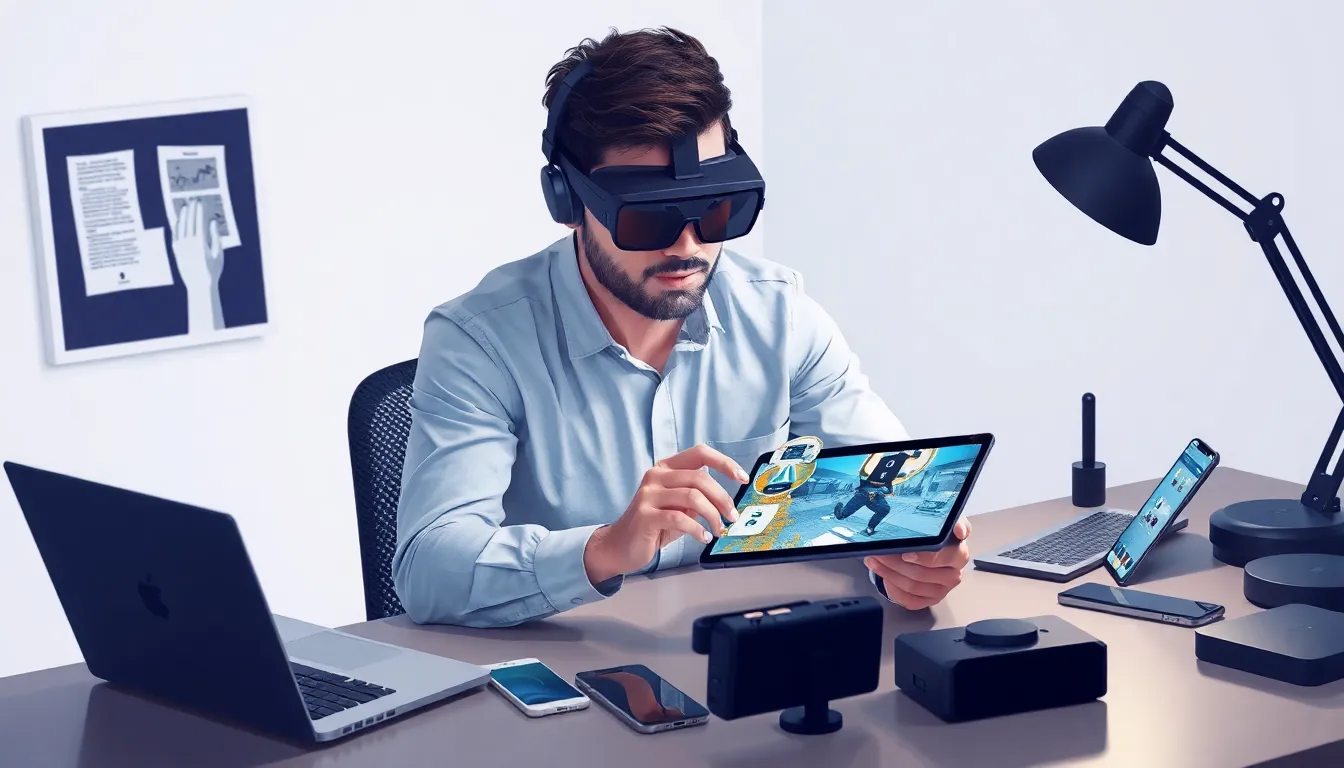Table of Contents
ToggleIn a world where reality just isn’t cutting it anymore, augmented reality developers are the wizards conjuring up magic right before our eyes. With a flick of their coding wands, they transform the mundane into the extraordinary, blending the digital and physical realms like a pro chef whipping up a gourmet dish. Imagine walking down the street and spotting a dragon lounging on your neighbor’s roof—thanks to these tech-savvy creators, that’s just another Tuesday.
But it’s not all fun and games; augmented reality developers are the unsung heroes of innovation. They’re shaping industries from gaming to education, making experiences more immersive and engaging. As businesses scramble to keep up with the latest trends, the demand for AR expertise is skyrocketing. So, if you’ve ever dreamed of creating a world where unicorns roam free or where your coffee cup gives you daily motivational quotes, this might just be the career for you.
Role of an Augmented Reality Developer
Augmented reality developers play a crucial role in merging the digital and physical environments. Their expertise shapes immersive experiences in various sectors, from entertainment to education.
Key Responsibilities
Creating engaging AR applications is a primary responsibility. They design interactive features that enhance user engagement and satisfaction. Collaborating with designers ensures visual elements align with technical specifications. Testing and troubleshooting applications is essential, as it guarantees functionality and user experience. Keeping up with technological advancements helps developers incorporate the latest tools into their projects.
Necessary Skills
Proficiency in programming languages like C# and JavaScript is vital for developers. Familiarity with AR development platforms, such as Unity and Vuforia, enhances project versatility. Strong problem-solving abilities drive innovation while critical thinking fosters effective solutions. Excellent communication skills enable effective collaboration with teams across different fields. A solid understanding of user interface design principles contributes to creating intuitive experiences for users.
Tools and Technologies

AR developers rely on a variety of tools and technologies to create immersive experiences. Knowledge of specific software frameworks and compatible hardware plays a significant role in the development process.
Popular Software Frameworks
Unity stands as one of the leading platforms for augmented reality development due to its flexibility and robust features. Vuforia enriches AR experiences by providing image recognition and tracking capabilities. ARKit, designed for iOS devices, offers tools for building AR experiences tailored for Apple users. Similarly, ARCore serves Android developers with a set of functionalities to create compelling applications. Familiarity with these frameworks enhances developers’ ability to craft engaging, interactive applications.
Hardware Considerations
AR developers must consider hardware compatibility when designing applications. Mobile devices tend to be the primary platform for AR experiences, so understanding specifications of smartphones and tablets is crucial. High-quality cameras and sensors on devices improve tracking and recognition. In addition, AR glasses gain traction, providing users with hands-free experiences. Ensuring the software integrates seamlessly with both mobile and wearable devices significantly impacts performance and user satisfaction.
Career Path
A career as an augmented reality developer involves a combination of education and practical experience. This pathway often begins with acquiring relevant qualifications and seeking opportunities in a rapidly evolving field.
Educational Requirements
Most employers expect a bachelor’s degree in computer science, software engineering, or a related field. Specialized courses focusing on AR technologies, user experience design, and interactive media enhance a developer’s skills. Many candidates also gain valuable insights through online courses that cover platforms such as Unity and Vuforia. Internships or co-op programs in AR firms provide hands-on experience vital for job readiness. Advanced degrees in artificial intelligence or user interface design may improve career prospects in competitive job markets.
Job Opportunities
Job opportunities for AR developers span various industries, including gaming, education, and retail. Roles encompass positions such as augmented reality software engineer, AR game designer, and user experience researcher. Companies like Google, Apple, and tech startups often seek talent with AR expertise. Freelance opportunities also exist, allowing developers to work on diverse projects. The demand for AR applications continues to grow, with the global AR market projected to reach $198 billion by 2025, providing ample opportunities for aspiring developers.
Challenges in Augmented Reality Development
Capable AR developers face several challenges during the development process. Navigating these complex issues requires a strong foundation in both technical and user experience aspects.
Technical Hurdles
Developers encounter various technical hurdles when creating AR applications. Device compatibility poses a significant challenge, as AR works differently on mobile devices and AR glasses. Performance optimization is crucial; poor frame rates lead to a subpar user experience. Additionally, accurate tracking and mapping require advanced algorithms and high-quality sensors. Developers must also address latency issues that can disrupt the immersion. Lastly, keeping up with rapidly evolving technology necessitates continuous learning and adaptation to new tools.
User Experience Issues
Creating an engaging user experience is a priority for AR developers. Complex interfaces can overwhelm users, detracting from the immersive experience. Designing intuitive navigation ensures users interact naturally with content. Feedback mechanisms also play a key role; timely responses to user actions enhance satisfaction. Moreover, developers must consider diverse user demographics and preferences to tailor experiences effectively. Testing with real users helps identify and resolve issues early in the design process. Balancing functionality and aesthetics remains an ongoing challenge as AR technology progresses.
Future Trends in Augmented Reality
Innovations in augmented reality promise to shape the future landscape of technology. Emerging technologies and industry applications drive the evolution of AR, creating exciting opportunities.
Emerging Technologies
Advancements in AR hardware and software significantly enhance immersive experiences. 5G connectivity improves data transfer speeds, enabling real-time interactions in active environments. Machine learning complements AR by optimizing user experiences through personalized content. Furthermore, spatial computing expands AR’s capabilities in recognizing and interpreting user surroundings. As AR glasses continue gaining traction, users expect lightweight designs with long battery lives. Enhanced sensors and camera technologies also contribute to better accuracy in tracking and mapping.
Industry Applications
In education, AR transforms traditional learning methods, offering immersive experiences beyond textbooks. Retail embraces AR by allowing customers to visualize products in their home environments. Collaborative workspaces utilize AR to facilitate remote teamwork, bridging distances through shared digital experiences. Healthcare benefits from AR applications by aiding in surgical procedures and patient education. The entertainment industry innovates through AR games, providing interactive experiences that engage players. As industries explore AR’s potential, the demand for skilled developers continues growing, underscoring the technology’s evolving role.
The future of augmented reality development is bright and full of opportunities. As industries increasingly adopt AR technology, the demand for skilled developers will only rise. Those who embrace the challenges and continuously evolve their skills will find themselves at the forefront of this exciting field.
With a blend of creativity and technical expertise, AR developers have the power to shape how people interact with the world around them. As they push the boundaries of innovation, their contributions will redefine experiences across gaming, education, healthcare, and beyond. The journey into augmented reality promises to be not just a career but a chance to be part of a transformative movement.







